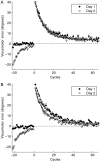Extinction interferes with the retrieval of visuomotor memories through a mechanism involving the sensorimotor cortex
- PMID: 24363266
- PMCID: PMC4428300
- DOI: 10.1093/cercor/bht346
Extinction interferes with the retrieval of visuomotor memories through a mechanism involving the sensorimotor cortex
Abstract
Savings is a fundamental property of learning. In motor adaptation, it refers to the improvement in learning observed when adaptation to a perturbation A (A1) is followed by re-adaptation to the same perturbation (A2). A common procedure to equate the initial level of error across sessions consists of restoring native sensorimotor coordinates by inserting null--unperturbed--trials (N) just before re-adaptation (washout). Here, we hypothesized that the washout is not innocuous but interferes with the expression of the new memory at recall. To assess this possibility, we measured savings following the A1NA2 protocol, where A was a 40° visual rotation. In Experiment 1, we increased the time window between N and A2 from 1 min to 24 h. This manipulation increased the amount of savings during middle to late phases of adaptation, suggesting that N interfered with the retrieval of A. In Experiment 2, we used repetitive TMS to evaluate if this interference was partly mediated by the sensorimotor cortex (SM). We conclude that the washout does not just restore the unperturbed sensorimotor coordinates, but inhibits the expression of the recently acquired visuomotor map through a mechanism involving SM. Our results resemble the phenomenon of extinction in classical conditioning.
Keywords: adaptation; anterograde interference; motor learning; null trials; sensorimotor cortex; transcranial magnetic stimulation.
© The Author 2013. Published by Oxford University Press. All rights reserved. For Permissions, please e-mail: journals.permissions@oup.com.
Figures







References
Publication types
MeSH terms
Grants and funding
LinkOut - more resources
Full Text Sources
Other Literature Sources

